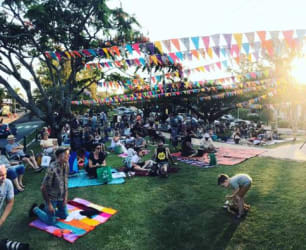The raging pandemic that Australia and the world faced over the past years forced a bunch of musicians into their underground bunkers and bedrooms, as gigs and concerts were cancelled and most of the fun stuff about the music life was curtailed. This practically compulsory creative season gave rise to a rising interest in home studios, as musicians who might otherwise be touring, selling tickets and merch, found themselves both short of cash for commercial studio time and in a more competitive environment for the studios available.
But what of the magic that makes a good studio? Can one design oneself a studio for one’s own creative processes? Can a professional studio be designed for home without breaking the bank? We talked to Guy Cooper, owner of Serotonin Productions, about the evolution of his studio setup over the two plus decades he’s been recording and what he likes best about his setup.
“I have produced over 2000 songs from hip-hop to metal, pop to folk and punk to funk, film audio and computer game audio. My studio space has grown over the past 25 years from a small bedroom setup with a laptop in my late teens to a hybrid analog/digital custom designed recording studio for my business, with a bit over a million dollars’ worth of vintage and modern pro audio equipment.
“What I love most is the freedom to create and do what I love; but possibly also the sound proofing, though that’s more for my partner, son and the neighbours! I had a studio in my old house that engulfed most of the living, bedrooms and kitchen areas, which was life for 20yrs, but my new studio is in a separate building. After spending the last 8 months designing and building, it’s glorious to have completely sound-proofed rooms that allow us to blast the most brutal metal I can generate at 2am and not have to worry about disturbances. It must be said, I do love my Hammond organ, guitar amps, 1176’s and nice mics as well though.”
So what are Cooper’s top tips for the budding recording studio entrepreneur?
“Do your research, figure out what you want from your space (do you need to track drums and guitars at 3am?) and, if you’re an artist, learn to do it yourself because paying a professional to build a studio is about four times as expensive as a house. There are so many forums and textbooks out there about it. The Master Handbook of Acoustics has everything you need, but it’s not light reading, I used it as the main textbook for my lectures when I lectured at SAE, but you’re going to need to breathe before diving into that. Finally, ask around, visit studios, and understand that sound proofing, and acoustics are related, but separate things.”
At the other end of the professional spectrum perhaps, former carpenter Matt Carins from GC folksters Hollow Coves, reflects on the little booth he created in the upper floor practice room the duo use to prepare for tours.
“Yeh, this booth only cost us about $1000. All the materials were from Bunnings. All the walls are filled with earthwall and then inside acoustic foam. But for us it’s just guitars and vocals.
We didn’t really know about recording but obviously with COVID, it wasn’t an option to go to other studios during that time. The skills we learnt we thought would be invaluable to have.
"The whole ‘Blessings’ EP was recorded in there.”
Carins and the other half of Hollow Coves, Ryan Henderson, sent the EP to be mixed in New York with Grammy Award winning engineer Patrick Dillett and got some pretty positive feedback.
“We were kinda expecting we would have to go back and change a lot. But Patrick’s feedback was that it sounded incredible, and perfect for our sound as a band. I actually feel like he was the first guy who really gets our music, especially with vocals.”
Carins seems sure, based on their experience, that creating your own studio is an achievable goal for bands like Hollow Coves, as long as you’re “capturing” well and he outlines this amongst his top three tips for those planning to give it a try.
“A good interface; mics and amps; good basics; focus on getting that capturing right has to be number one. We use Universal Audio hardware with plug-ins. Second, a dead space is key. A converted wardrobe could work. Our booth is really tight, and really dead. It’s fine if you can eliminate all noise. And finally, air conditioning. You can spend a lot of time in, and on, a studio and keeping yourself cool is important.”
There’s no doubt that realistic expectations are key whether you’re a decades experienced sound engineer like Guy Cooper creating studio space for big heavy metal sounds, or whether you’re creating sneaky functional space for an acoustic guitar and voice. Leveraging technology to your advantage is also an important thought, and being aware of the latest software. The Gold Coast community is a helpful crew though and with guys like these willing to share their knowledge there’s no doubt asking for help and advice is going to save the home studio entrepreneur time and money, whatever the scale of your aspirations.













